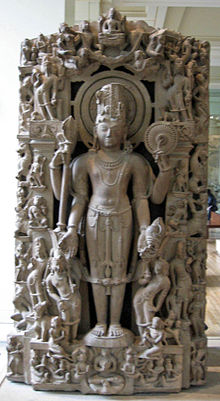Harihara

Harihara ( Sanskrit हरिहर harihara ) is a deity of Hinduism . It represents a union of the aspects of Vishnu (Hari) and Shiva (Hara) . The nature of this unity is understood differently by different Hindu schools. Harihara is also called Shankaranarayana ("Shankara" for Shiva, and " Narayana " for Vishnu). Both Vishnuits and Shivaites worship this deity , either as a form of the highest god or generally as a venerable figure.
meaning
The nature of Vishnu and Shiva in Hinduism has often been the subject of debates from their followers and various schools of philosophy . Among the followers of the two main gods of India, the Shivaites and the Vishnuits , discussions flared up again and again as to which god was the more powerful or the more all-embracing. Since there were enough arguments for both positions, an attempt was made to harmonize both extremes - initially only as a spiritual concept, later also in figurative representations, the image of a single deity gradually emerged who represented the opposing aspects of the Hindu world of faith (asceticism, savagery and destruction embodied by Shiva on the one hand and responsibility, nobility and protection embodied by Vishnu on the other hand) united in themselves.
The Indian philosopher Sivananda sums it up in the first half of the 20th century as follows:
- Shiva and Vishnu are one and the same entity. They are essentially one and the same. They are the names given to the different aspects of the all-pervading Supreme Parabrahman, the Supreme Being or the Absolute. 'Sivasya hridayam vishnur-vishnoscha hridayam sivah - Vishnu is the heart of Siva and likewise Siva is the heart of Vishnu'.
- ("Shiva and Vishnu are one and the same unit. They are essentially one and the same. They are names for the different aspects of the all-pervading world soul, the Supreme Being or the Absolute ... Vishnu is the heart of Shiva and Shiva is the heart Vishnus. ")
distribution
The main area of distribution of the Harihara cult, which was probably first mentioned in Harivamsha , was, besides India, the Khmer empire in what is now Cambodia and Thailand around the middle of the 1st millennium, i.e. in the pre- Angkor period.
The oldest Khmer capital in the Angkor area was named after the deity Hariharalaya , but later Vishnu became the imperial god to whom the buildings of the classical Angkor period (such as Angkor Wat in particular ) were dedicated.
Harihara was also the name of the founder of the Vijayanagar empire in southern India.
presentation
In India and Southeast Asia, Harihara is usually represented as a man with four arms, two of them - often with a trident ( trishula ) and an hourglass drum ( damaru ) - are assigned to Shiva, the other two hold attributes of Vishnu (throwing disc ( chakra ) and shell (shankha)) . The two-part crown of the god is easy to recognize - one half consists of the braided and tied hair of Shiva ('lichen crown'); the half assigned to Vishnu is often referred to as the 'crown of the pot'.
See also
Further attempts to overcome fundamental contradictions within the Hindu world of faith can be found in the ideas of
Web links
Individual evidence
- ↑ Pranabananda Jash: Syncretistic Cult in Cambodia. In: Proceedings of the Indian History Congress, Vol. 39, II, 1978, pp. 924-929, here p. 924
- ↑ Anneliese and Peter Keilhauer: The visual language of Hinduism. The Indian world of gods and their symbolism. DuMont, Cologne 1983, p. 52f ISBN 3-7701-1347-0 .
